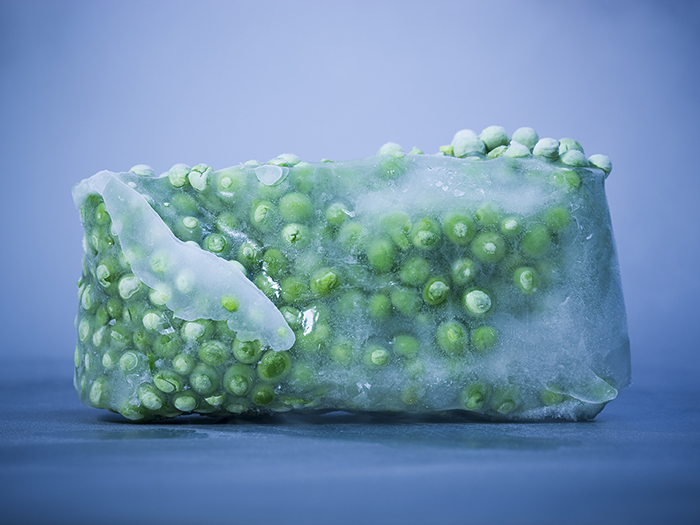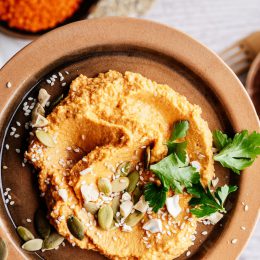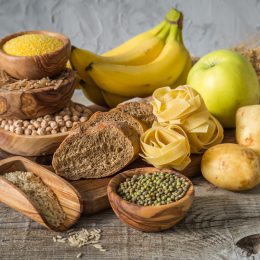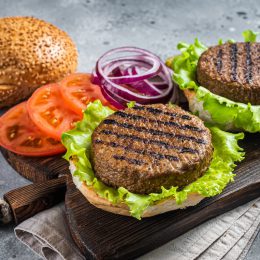13 Best Foods to Keep in Your Freezer, According to Nutritionists
When it comes to healthy staple ingredients, fresh isn’t always best. These frozen foods deliver key nutrients—and help you save time and money.

Imagining delicious, nutritious meals is one thing. Prepping said meals? Well, that’s another story entirely. Somewhere between buying the right ingredients and carving out enough time to chop, measure, season, and actually cook is where those good intentions slip away.
“Time is one of the biggest factors that influences our ability to make healthy decisions,” says Emily Kyle, R.D.N., owner of Emily Kyle Nutrition in Rochester, New York. “I love anything that takes the time barrier away.”
Enter freezer staples. While there’s no way to eliminate meal prep completely, having the right mix of frozen ingredients all ready to go is key for anyone who’s both hungry and busy.
First, food keeps far longer in the freezer than it does in the fridge or at room temperature. That means you can buy things in bulk, or do one big grocery trip to pick up staples for a whole month and stick them in the freezer for later. Fewer trips to the store means a lot of saved time and energy.
Second, many foods in the freezer section come already cut, cooked, or both. At the very least, it means you don’t have to waste time washing and chopping, or cleaning a knife and cutting board. At best, it means all that stands between you and dinner is a few minutes in the microwave, or a little more time in a pan or oven.
Not sure where to start when it comes to freezer staples? We asked Kyle and other nutrition experts about the ingredients they always keep in stock.
The Meal Builders
You’ll always have the foundation for a quick, healthy meal with these frozen options that deliver whole grains and lean protein.
Cooked Grains
Your favorite whole grains, such as brown rice, quinoa, and barley, can now be found already prepared in the freezer section. Or you can cook a big batch of dry grains one day, freeze individual servings, and thaw them in the microwave whenever you want them.
“All you have to do is microwave a bag before enjoying your favorite quinoa bowl or easy dinner side dish,” Kyle says.
These whole grains, which contain all the parts and nutritional value of the original kernel, help you meet your daily fiber quota. For women 51 and older, that’s 21 grams of fiber per day, and for men, that’s 30 grams, according to the National Academy of Medicine. Hitting these targets helps keep your digestive system humming and cuts your risk for heart disease. Bonus: Whole grains are also one of the best carbs for weight loss.
Fish Fillets
Fish is a great source of lean protein. Fatty fish like salmon and trout also pack a particular type of omega-3 fatty acid known as docosahexaenoic acid, or DHA, which helps safeguard your brain health. In fact, some studies show higher consumption of omega-3 foods is linked to a lower risk for Alzheimer’s disease and dementia, according to the National Institutes of Health.
The 2015 Dietary Guidelines for Americans recommends at least eight ounces of seafood, including fish, each week. But fish can be expensive, and its life in the refrigerator is short. Frozen, individually packaged fillets are often less expensive, and they cut the possibility of spoilage and waste.
“Pull out frozen fish in the morning, leave it in the fridge to defrost, then cook it when you get home at the end of the day,” says Alissa Rumsey, R.D., owner of Alissa Rumsey Nutrition and Wellness in New York. “I like to sauté or panfry fish, and add it into a soup, salad, stir-fry, or noodle dish.”
You can also make a delicious dinner with just three ingredients: salmon, Brussel sprouts, and lemon.
Ground Meat or Lentils
Buy ground chicken, turkey, or beef in bulk, and divide it into smaller portions before freezing in airtight containers or bags. When you want to use a portion, transfer it from freezer to fridge in the morning, and it’ll be thawed by evening.
“When it’s completely thawed, prepare it as you like, and throw it on top of pasta dishes, salads, or stir-fries,” Rumsey says.
Ground meat is often overlooked in nutrition headlines, but these foods are prime sources of protein, a nutrient your body needs to repair cells, build muscle, and even fight infection. Watching your calorie and saturated fat intake? Look for lean ground meats.
Not a meat eater? Frozen lentils are terrific protein-packed vegetables that are incredibly easy to prep and can be used in place of meat in many dishes.
Meat or Veggie Burgers
“These are really helpful for quick weekday meals, as they take just a few minutes to defrost in a pan over medium heat,” Rumsey says. “They’re perfect to throw into a sandwich, or to break apart and toss with a salad to add a protein.”
Another idea: You can crumble the burgers up and mix them into tomato sauce to serve over pasta.
It’s easy to find protein-packed veggie burgers in the freezer section of your local store. Two popular options among dietitians: MorningStar Farms Grillers Original Veggie Burgers and Beyond Meat Beyond Burger. But you can also freeze your own homemade bean or turkey burgers—just cook a few extra the next time you’re firing up the grill.
The Nutrition Powerhouses
Struggle to hit your daily requirement of fruits and vegetables? These frozen options make it so much easier to get the produce—and nutrients—you need.
Bananas
Have you ever bought a bunch of bananas only to watch them slowly turn to black on your kitchen counter? Don’t let those ripe bananas go to waste! If you spot them turning brown, peel and freeze them before they turn totally black.
“You can toss them in the blender for a smoothie, or put them on top of oatmeal or yogurt,” Rumsey says. You can also let them thaw a little bit to use in recipes that call for mashed banana, like banana breads and muffins. Or slice and top them with a small dollop of dark chocolate spread before freezing for an easy grab-and-go treat.
Besides being versatile, bananas are a great source of fiber and potassium, which is an electrolyte that helps your heart beat regularly. They’re also easy to digest—a plus for anyone with stomach ailments.
Berries
“We know that raspberries, blackberries, and blueberries are among the healthiest foods for us, but fresh berries can be pricey, especially when they’re not in season,” Kyle says. “Thankfully, frozen berries are available year-round and are often more affordable than fresh.”
Frozen at the peak of freshness, these berries still contain all of the important antioxidants, vitamins, and minerals their fresh counterparts offer. In fact, because fresh berries may lose some of their nutrients during transportation or on the shelf, frozen berries may be healthier.
Your heart, for one, may benefit. Women who ate blueberries and strawberries three or more times a week had a 32 percent lower risk of heart attack, compared with women who only ate the berries once a month or less, according to a large study in Circulation. Researchers credit flavonoids, a type of antioxidant that helps keep blood vessels open.
Kyle likes to stir frozen berries into yogurt, oatmeal, and pancake batter, or blend them into smoothies. Defrosted, they also liven up salads and salsas.
Cauliflower
“One of the most versatile vegetables, frozen cauliflower can be steamed, pureed, and more,” Kyle says. You can even put it into the food processor or use a grater to make cauliflower rice, which you can substitute for regular rice.
Her favorite trick? Roasting cauliflower straight from the bag, using just a little olive oil and some spices.
You can feel good about this timesaver, Kyle adds, because eating more cauliflower and other cruciferous vegetables like broccoli have been associated with lower risk for heart disease and stroke. They’re also thought to help tame inflammation.
Green Peas
Stocking up on frozen peas is a no-brainer, says Jackie Newgent, R.D.N., a culinary nutritionist and author of The All-Natural Diabetes Cookbook.
“Fresh peas often come with their shells still on, so they require quite a bit of prep work before you even start cooking,” she says. “Plus, frozen peas add a pop of bright green color to dishes, and they require basically no cooking.”
Subscribe to our newsletter
It's quick and easy. You could be one of the 13 million people who are eligible.
Already a member? Click to discover our 15,000+ participating locations.
Follow Us
Try stirring them into pasta or rice dishes, like pasta primavera, pesto gnocchi, or lemony risotto. Just add the frozen peas during the last couple of minutes of cooking, and you’ve got an incredibly easy one-pot meal.
On the nutrition front, with just a half-cup serving of green peas, you’ll get four grams of protein and almost the same amount of fiber, plus a host of vitamins and minerals. And all for just 62 calories.
Prunes
Tart yet sweet, prunes—also known as dried plums—are one of Newgent’s go-to flavorings for drinks. Skip the ice cubes, and drop a few frozen wedges into a glass of iced tea or sparkling water.
Newgent also likes them for blended beverages. “I make a cocoa smoothie that has gut- and bone-health benefits thanks to frozen prunes, which I use instead of ice cubes,” she says. “Just blend milk, frozen prunes, and unsweetened cocoa powder, strain, and enjoy.”
The gut-health benefits come from three grams of fiber in just five prune wedges. And a daily serving of prunes may help slow bone loss, especially in postmenopausal women with low bone density, according to a study in Osteoporosis International.
Vegetable Blends
“Precut frozen vegetables can be added to any meal and only require a few minutes to steam on the stove or roast in the oven,” Rumsey says.
Buying vegetable blends is a great way to add flavor and nutrient variety without having to think about it. “I love to toss them into a stir-fry, grain bowl, pasta dish, or put them on top of pizza or a fresh salad,” she adds. “They’re especially useful in the winter months when fewer fresh veggies are in season.”
The Finishing Touches
With these foods in your freezer, you’ll be ready to make an appetizer, side, or meal topping in minutes.
Bread
“Keeping bread in the freezer means it lasts longer,” Rumsey says. That’s especially great news if you love buying bread or bagels from a local bakery. These fresh breads don’t have the preservatives that most store-bought sliced breads have, so they’ll go stale pretty quick at room temperature.
If you’re freezing whole loaves, be sure to slice them first. “You can take slices of bread right from the freezer and stick them in a toaster,” Rumsey says. “There’s no need to defrost first.”
Newgent also suggests freezing whole grain pita rounds to use in a pinch as a pizza crust or appetizer for last-minute entertaining. “They take up little space and thaw quickly,” she says. “Cut a pita into wedges, and serve with hummus. Or brush with olive oil, sprinkle with sesame seeds and thyme, and then bake into pita chips to serve with salads or to pair with a fancy cheese platter.”
Hash Browns
It’s easy to find ready-to-cook hash browns in the freezer section, and they really come in handy when you’re in need of a starchy side to a meal—breakfast or dinner. Take them right out of the freezer, and heat them in a pan with a little bit of olive oil until they’re crispy.
Nuts
“Nuts have plenty of unsaturated healthy fats, which can help protect against heart disease,” Newgent says. “But you’ll lose some of the power of those good fats if you keep them at room temperature for months and months. That’s why they’re ideal for the freezer.”
Because they’re small and high in fat, nuts thaw pretty quickly—about 15 minutes at room temperature, or less than a minute in a pan or the microwave. Sprinkle a small handful of nuts on everything from salads to rice pilaf for a boost of nutrition, crunch, and flavor.
Take Your Favorite SilverSneakers Classes Online!
SilverSneakers members can access live fitness classes and wellness workshops through SilverSneakers LIVE. See the latest schedule and RSVP for classes here.
Not a member? If you have a Medicare Plan, it may include SilverSneakers—at no additional cost. Check your eligibility instantly here.





